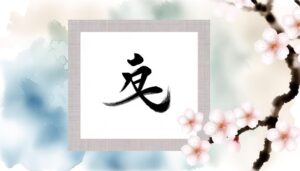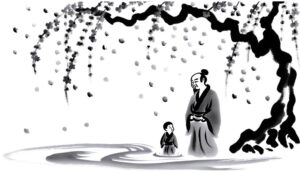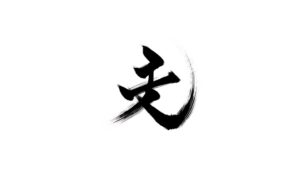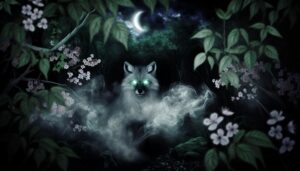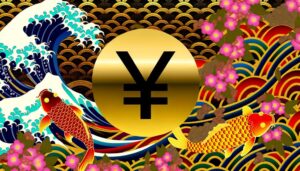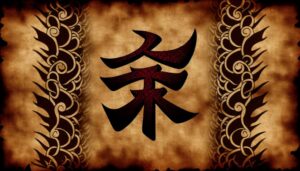What Is the Japanese Symbol for Dragon?
The symbol for dragon in Japanese, depicted by the kanji characters '竜' (Shinjitai: 竜) or '龍' (Kyūjitai: 龍), holds immense cultural and spiritual significance. Rooted in mythological origins, these dragons (ryū) are emblematic of strength, wisdom, and protection.
Traditionally revered as benevolent water deities, they control rainfall and tides, ensuring agricultural prosperity. This reverence is deeply embedded in religious practices, historical texts, and artistic expressions.
The majestic ryū adorns traditional art forms, literature, and modern media, continuing to captivate and inspire. Discover the intricate layers of cultural narratives surrounding this esteemed symbol further.
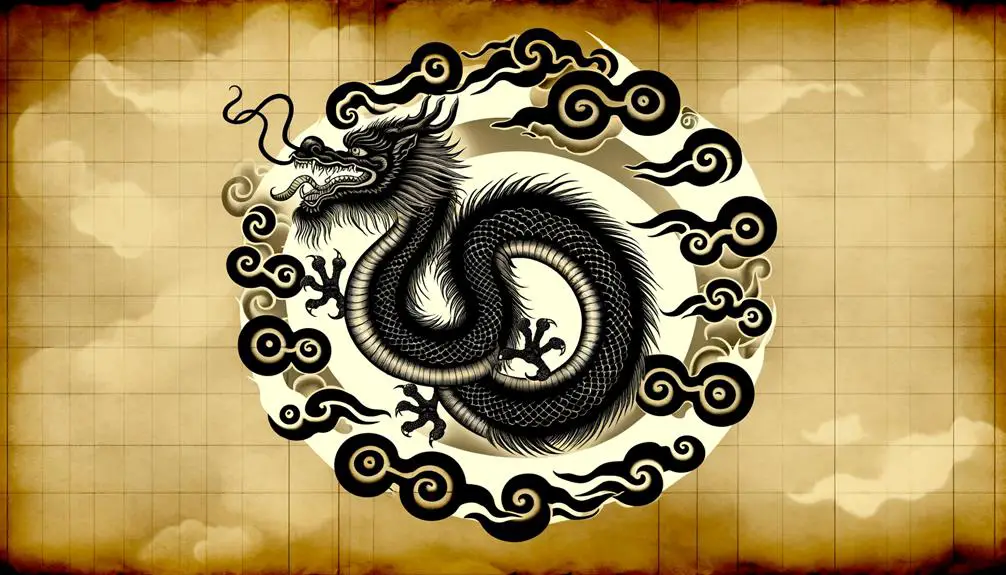
Key Takeaways
- The symbol for dragon in Japanese is represented by the kanji characters 竜 or 龍.
- Dragons are venerated as symbols of strength, wisdom, and protection in Japanese culture.
- The term 'ryū' (龍) refers to dragons in Japanese mythology and folklore.
- Dragons are depicted as benevolent guardians of rain and agricultural prosperity.
- In art and literature, dragons symbolize cosmic forces, power, and spiritual transcendence.
Historical Significance
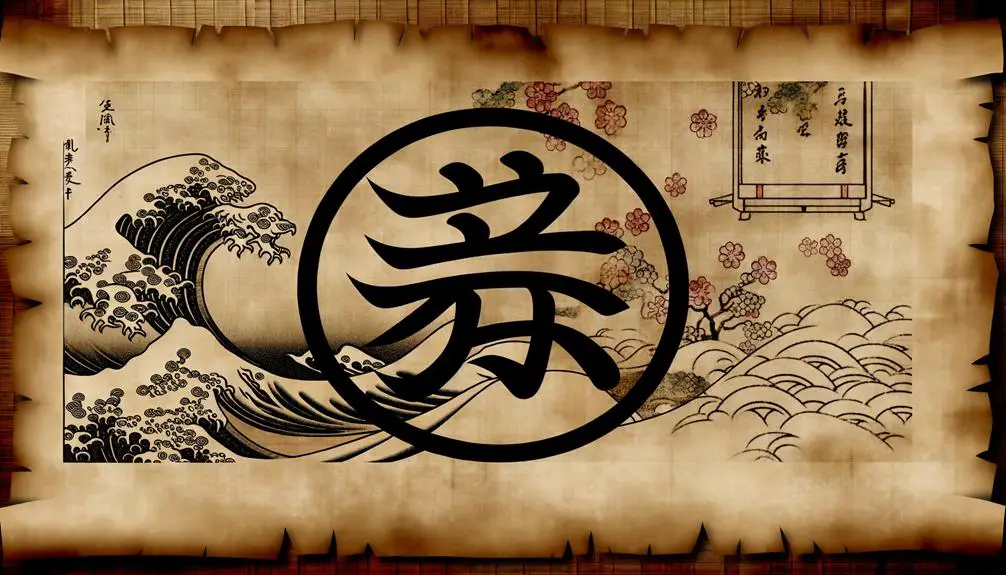
Throughout Japanese history, the symbol for dragon (竜 or 龍) has held profound cultural and spiritual significance, deeply rooted in ancient mythology and folklore. These mythical beings are venerated as potent symbols of strength, wisdom, and protection.
Intrinsically linked to water and the heavens, dragons are often depicted as benevolent guardians of rain and agricultural prosperity. Their reverence can be observed in various historical texts, religious practices, and artistic expressions, including ukiyo-e prints and temple carvings.
The dragon's enduring presence in Japanese culture is also evident in festivals such as the Nagasaki Kunchi, where dragon dances are performed to invoke blessings. This rich tapestry of dragon symbolism underscores their pivotal role in shaping Japan's cultural and spiritual landscape.
Mythological Origins
The mythological origins of the dragon symbol in Japanese culture are deeply interwoven with ancient folklore, reflecting the nation's rich tapestry of legends.
Dragons, or 'ryū' (龍), have evolved from being formidable deities of water and weather to emblematic figures embodying power and wisdom.
This evolution in dragon symbolism underscores a dynamic interplay between indigenous beliefs and external influences, particularly from Chinese mythology.
Ancient Japanese Folklore
Rooted in the ancient tapestry of Japanese folklore, the dragon, or 'ryū' (竜 or 龍), embodies a rich synthesis of mythological origins and cultural symbolism. In Japanese mythology, ryū are often seen as benevolent water deities, contrasting their Western counterparts. They are believed to control rainfall and tides, pivotal for agrarian societies.
| Element | Significance | Representation |
|---|---|---|
| Ryū | Dragon | Water deity |
| Mizuchi | Water dragon | River spirit |
| Yamata no Orochi | Eight-forked serpent | Ferocity, chaos |
| Ryūjin | Dragon god | Sea and storms |
| Tatsunoko | Children of dragons | Nobility, power |
These entities, through their multifaceted roles, underscore the profound reverence within ancient Japanese culture towards dragons.
Dragon Symbolism Evolution
Evolving from ancient mythological origins, dragon symbolism in Japanese culture has undergone significant changes, reflecting shifts in societal values and religious beliefs. Initially, dragons, or 'ryū' (龍), embodied natural forces and were revered as deities of water and agriculture, integral to Shinto and Buddhist traditions.
Over centuries, their portrayal evolved, integrating Taoist and Confucian ideals, symbolizing power, wisdom, and protection. The dragon's image shifted from fearsome, chaotic entities to benevolent guardians of the cosmos, mirroring Japan's transformation from a nature-centric worldview to a more structured, philosophical approach.
This evolution underscores the fluid nature of mythological symbols, adapting to cultural changes while retaining core elements that resonate with the Japanese ethos and spiritual landscape.
Kanji for Dragon
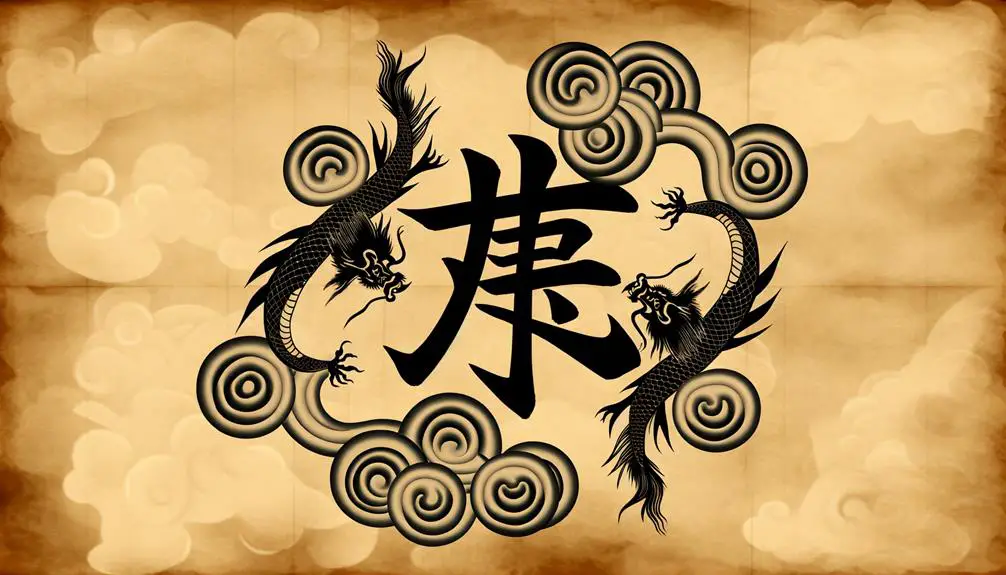
In Japanese, the kanji for 'dragon' (竜 or 龍) embodies a rich tapestry of cultural symbolism and historical significance.
The character 竜 (ryū) is the simplified form, commonly used in modern contexts, while 龍 (ryū) is the traditional form that holds deeper historical roots.
Both kanji are imbued with connotations of power, wisdom, and mysticism, reflecting the dragon's revered status in East Asian mythologies.
The kanji 龍, with its intricate structure, is often employed in formal and artistic expressions, underscoring the dragon's majestic and auspicious nature.
Understanding these kanji provides a window into the complex interplay between language, culture, and history in Japan, where the dragon continues to be a potent symbol of strength and benevolence.
Symbolism in Art
The depiction of dragons in Japanese art is a profound demonstration of their symbolic significance, encapsulating themes of power, protection, and spiritual transcendence. These mythical creatures are often portrayed with a majestic dynamism, embodying the cosmic forces they are believed to control.
- Intricate ink paintings showcasing dragons coiling through clouds, symbolizing their dominion over the heavens and weather.
- Elaborate woodblock prints depicting dragons amidst turbulent seas, signifying their mastery over water bodies.
- Ornate sculptures in temples, representing the dragon's role as a guardian of sacred spaces.
- Elegant kimono designs featuring dragon motifs, reflecting status and invoking protective energies.
Such artistic representations are not merely decorative but convey profound cultural narratives and spiritual beliefs deeply rooted in Japanese tradition.
Dragon in Literature
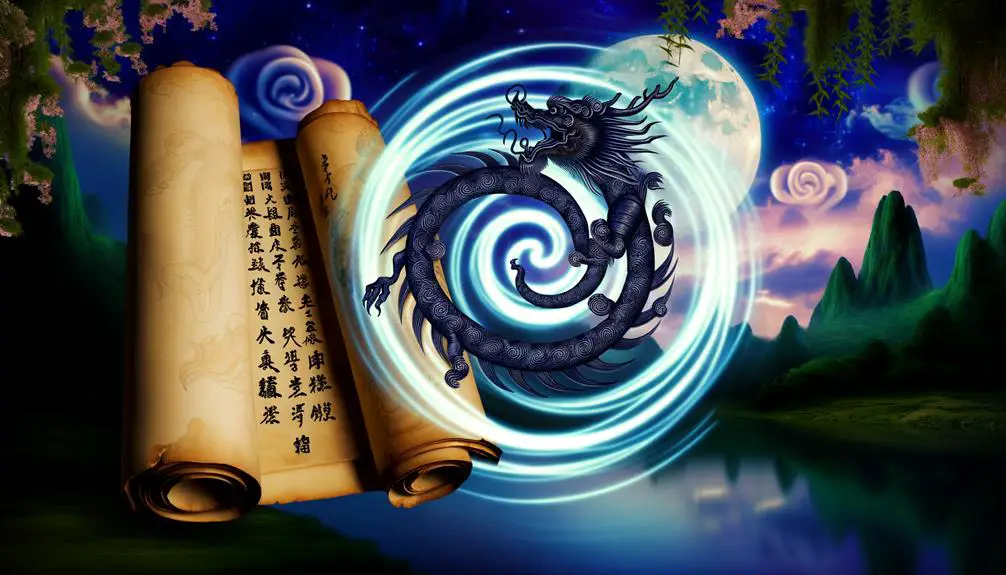
The dragon has long been an emblematic figure in Japanese literature, embodying a range of archetypal themes from divine guardianship to untamed chaos.
Traditional myths portray dragons as celestial beings wielding immense power, while modern novels often reinterpret these ancient symbols to explore contemporary societal issues.
This literary evolution underscores the dragon's enduring versatility and its profound impact on Japanese cultural narratives.
Mythical Dragon Archetypes
Exploring the rich tapestry of literature, one finds that the dragon archetype embodies a spectrum of symbolic meanings, from formidable guardian to wise sage, particularly in Japanese mythology. Dragons in Japanese literature are often depicted as majestic, serpentine beings with profound wisdom and elemental command.
These mythical creatures are not merely embodiments of power but also intricate symbols of natural forces and spiritual guardianship.
- Ryūjin: The Dragon King, ruler of the oceans, symbolizes the unfathomable depths and mysteries of the sea.
- Fūjin: Wind dragon, representing the capricious and unpredictable nature of the wind.
- Seiryu: Azure Dragon, one of the Four Symbols, guarding the eastern heavens.
- Tatsu: Traditional Japanese dragon, often depicted as a benevolent protector and bearer of rain.
Dragons in Modern Novels
In modern novels, dragons frequently emerge as complex characters, embodying a rich interplay of ancient symbolism and contemporary themes. These literary dragons often transcend their mythological origins, evolving into multifaceted beings that reflect societal values, ethical dilemmas, and personal growth. From benevolent guardians to fearsome adversaries, their portrayal varies noticeably, influenced by cultural narratives and authorial intent.
| Novel | Author | Dragon's Role |
|---|---|---|
| 'Eragon' | Christopher Paolini | Mentor and ally |
| 'The Hobbit' | J.R.R. Tolkien | Antagonist and treasure hoarder |
| 'Temeraire' | Naomi Novik | Companion and warrior |
| 'The Priory of the Orange Tree' | Samantha Shannon | Protector and symbol of unity |
The nuanced depiction of dragons in these works underscores their enduring allure and adaptability within modern literature.
Dragons in Folklore
Rooted deeply in cultural narratives, dragons in Japanese folklore are emblematic of both protective and destructive forces, embodying a complex duality that is reflected in their symbolic representation.
These mythical creatures are depicted as serpentine beings, often associated with water and weather, symbolizing the cyclical nature of creation and destruction. This duality is evident in how dragons are revered as guardians of sacred spaces and feared as bringers of natural calamities.
- Majestic, elongated bodies coiling through clouds
- Mysterious, glowing eyes conveying ancient wisdom
- Scales shimmering like a river under moonlight
- Fierce, commanding presence that commands respect
Such vivid imagery underscores the dragons' integral role in Japanese folklore, illustrating their multifaceted nature and profound cultural significance.
Religious Connections
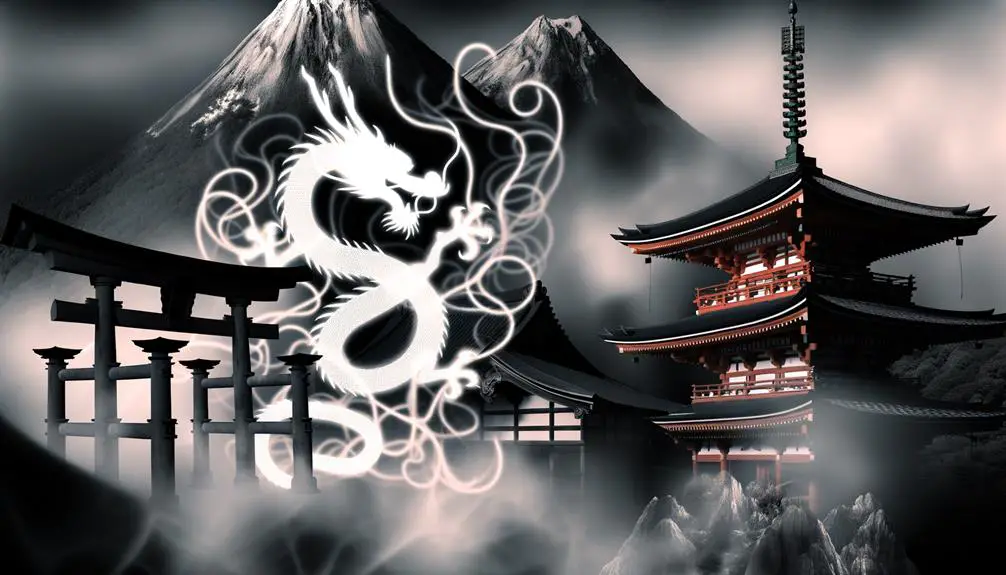
Frequently revered in religious contexts, Japanese dragons are often intertwined with Shinto and Buddhist practices, symbolizing divine intervention and spiritual potency.
In Shintoism, dragons are considered kami, or spirits, embodying natural forces and are venerated at numerous shrines. They are seen as protectors of water sources, pivotal for agricultural prosperity.
Meanwhile, in Buddhism, dragons are depicted as celestial beings, guarding sacred scriptures and temples. The Nihon Ryū, or Japanese dragon, is believed to possess the power to transcend domains, bridging the earthly and the divine.
This dual representation underscores the dragon's role as a guardian and mediator, reflecting a deep-seated cultural reverence for these mythical creatures within Japan's religious tapestry.
Modern Interpretations
Embracing contemporary culture, the symbol of the dragon in Japan has evolved, finding new expressions in art, literature, and popular media. This mythological creature, known as 'ryū' (龍), has transcended traditional boundaries, symbolizing power, wisdom, and protection in modern interpretations.
Anime and Manga: Iconic series such as 'Dragon Ball' have immortalized the dragon as a wish-granting entity, influencing global audiences.
Video Games: Titles like 'Final Fantasy' feature dragons as formidable adversaries and allies, enriching gameplay with their majestic presence.
Fashion: Dragon motifs are prevalent in contemporary clothing and tattoos, representing strength and resilience.
Literature: Modern Japanese authors often weave dragons into fantasy narratives, blending ancient lore with innovative storytelling.
These adaptations illustrate the enduring significance of the dragon in Japanese culture.
Dragon in Festivals
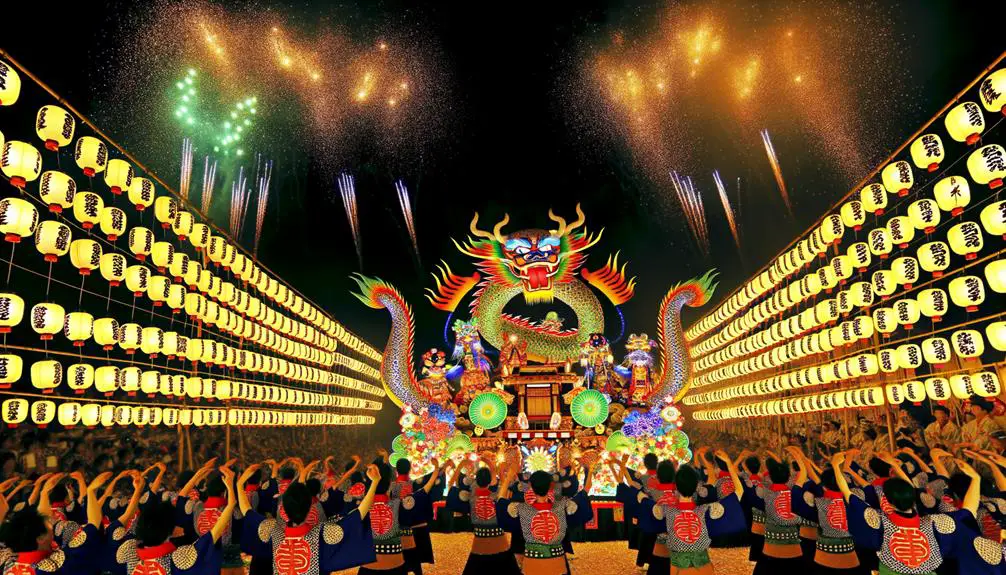
Dragons are prominently featured in various Japanese festivals, where traditional performances such as dragon dances captivate audiences with their elaborate choreography and vibrant costumes.
These festivals underscore the cultural significance of dragons, symbolizing power, protection, and prosperity.
Understanding the role of dragons in these celebrations provides deeper insight into their revered status within Japanese society.
Traditional Festival Performances
Traditional Japanese festivals often feature elaborate dragon performances, which are imbued with rich cultural symbolism and historical significance. These spectacles are a fusion of artistry and tradition, conveying the dragon's revered status in Japanese culture.
The performances often include:
- Majestic dragon puppets: Intricately designed and manipulated by skilled performers, showcasing the dragon's dynamic movements.
- Vibrant costumes: Adorned with vivid colors and elaborate designs, symbolizing the dragon's mythical power and grandeur.
- Traditional music: Played on taiko drums and flutes, creating an enthralling auditory experience that complements the visual spectacle.
- Ritualistic dances: Choreographed to mimic the dragon's serpentine grace, embodying stories of prosperity, protection, and fortune.
These elements collectively create a mesmerizing tableau, reflecting the deep-rooted reverence for dragons in Japanese culture.
Cultural Significance Explained
The dragon's presence in Japanese festivals is a manifestation of the country's deep-rooted beliefs in protection, prosperity, and the divine, offering a powerful symbol that resonates across generations.
Integral to events like the Nagasaki Kunchi and the Chinese New Year celebrations in Yokohama, the dragon, or 'ryū' (竜), embodies majestic strength and benevolence. These festivals feature elaborate dragon dances and processions, where participants don vibrantly colored dragon costumes, invoking mythical guardianship and auspicious fortunes.
The dragon's serpentine movements symbolize the flow of positive energy or 'ki' (気), believed to cleanse and revitalize the community. Therefore, the dragon in Japanese festivals is not merely a spectacle but a profound cultural emblem interwoven with historical reverence and contemporary significance.
Regional Variations
Across different regions in Japan, the symbol for dragon, or '竜' (ryū), often exhibits unique stylistic and cultural nuances. The visual and conceptual representations of dragons can vary significantly, reflecting local traditions and artistic influences.
These regional variations enrich the cultural tapestry of Japan and offer fascinating insights into how symbolism evolves within different contexts.
- Kyoto: Dragons depicted in traditional kimonos and textiles often incorporate intricate, flowing lines, symbolizing elegance and grace.
- Okinawa: Known for vibrant and colorful designs, dragons here are often more dynamic, reflecting the island's unique Ryukyuan heritage.
- Tokyo: Urban art frequently portrays dragons with a contemporary, edgy aesthetic, blending modernity with tradition.
- Hokkaido: Dragons in indigenous Ainu art often feature distinct patterns and motifs, emphasizing harmony with nature and spiritual elements.
Dragon Tattoos
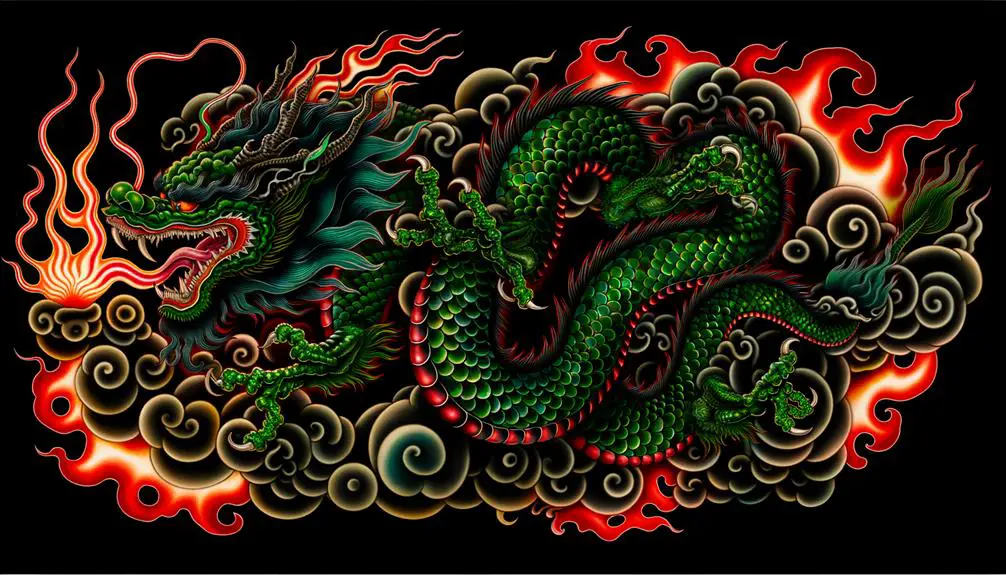
Dragon tattoos in Japan are emblematic of profound cultural symbolism, intertwining themes of power, protection, and spirituality.
Known as 'ryū' ( 龍 or 竜), these mythical creatures are deeply embedded in Japanese folklore and art.
Traditionally, dragon tattoos are not merely decorative; they embody the bearer's aspirations for strength and guardianship.
The imagery often incorporates elements like water, indicative of the dragon's dominion over natural forces, and clouds, symbolizing transcendence.
These tattoos are frequently rendered in vibrant hues, reflecting the dragon's dynamic and multifaceted nature.
The intricate designs and placement, often covering large areas of the body, signify a commitment to embodying the virtues associated with these legendary beings.
Consequently, dragon tattoos serve as a canvas for personal and cultural narratives.
Influence on Pop Culture
In contemporary pop culture, the Japanese symbol for dragon ('ryū' or 龍/竜) has transcended traditional boundaries, influencing various mediums from anime and manga to video games and fashion. This iconic symbol, deeply rooted in Japanese folklore, has found new expressions and interpretations that captivate global audiences.
- Anime and Manga:
Epic tales often feature dragons as central characters, symbolizing power and wisdom.
- Video Games:
Titles like 'Dragon Quest' and 'Final Fantasy' integrate dragons as formidable foes or allies.
- Fashion and Accessories:
Dragon motifs adorn apparel, jewelry, and tattoos, signifying strength and protection.
- Movies and Television:
Films and series incorporate dragon imagery, highlighting its mystique and grandeur.
These cultural elements enrich pop culture, fostering a deeper appreciation for Japanese symbolism.
Conclusion
The dragon, an emblem woven into the intricate tapestry of Japanese culture, emerges as a symbol of immense power and profound wisdom. Its mythological roots and kanji representation reveal a rich historical narrative, while its presence in art, literature, and festivals underscores its enduring significance.
Regional variations and modern adaptations, such as tattoos and pop culture, further illustrate the dragon's versatile influence, embodying the eternal dance between tradition and contemporary expression.

